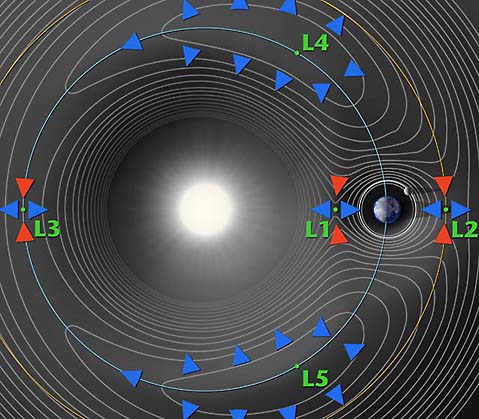Lagrange Points explained
 Normally I'd leave this sort of thing to my friend Ian Musgrave at Astroblog to explain, but it's cool, so there. NASA explains Lagrange Points for the WMAP Observatory in an accessible and cool way. I particularly like the "contour" diagram of forces acting on a body in the system. L1, L2 and L3 are effectively unstable because they are at the "top" of the gravitational potentials, like marbles on top of saddles, while L4 and L5 are at the "bottom" of the gravitational potentials, and if they deviate from that point, they will end up in an orbit around those points rather than moving away.
Normally I'd leave this sort of thing to my friend Ian Musgrave at Astroblog to explain, but it's cool, so there. NASA explains Lagrange Points for the WMAP Observatory in an accessible and cool way. I particularly like the "contour" diagram of forces acting on a body in the system. L1, L2 and L3 are effectively unstable because they are at the "top" of the gravitational potentials, like marbles on top of saddles, while L4 and L5 are at the "bottom" of the gravitational potentials, and if they deviate from that point, they will end up in an orbit around those points rather than moving away.This probably explains the behaviours of Near Earth Objects like 3753 Cruithne which has a "kidney bean" shaped orbit that is affected by earth's as well as the sun's gravitational pull. But that sort of math hurts my head.
 The WMAP Observatory has hit the news lately with a more detailed background radiation map of the sky, indicating some interesting things about the Big Bang. One is that it supports the simpler inflation theories. Another is that there appears to be some bias in the polarisation of the radiation, which is odd. We would expect that it would be randomly polarised. I haven't heard of any interpretations of this yet, but expect some ID misconstrual (along the lines of the Designer is actually very neat).
The WMAP Observatory has hit the news lately with a more detailed background radiation map of the sky, indicating some interesting things about the Big Bang. One is that it supports the simpler inflation theories. Another is that there appears to be some bias in the polarisation of the radiation, which is odd. We would expect that it would be randomly polarised. I haven't heard of any interpretations of this yet, but expect some ID misconstrual (along the lines of the Designer is actually very neat).Over to Ian...




<< Home